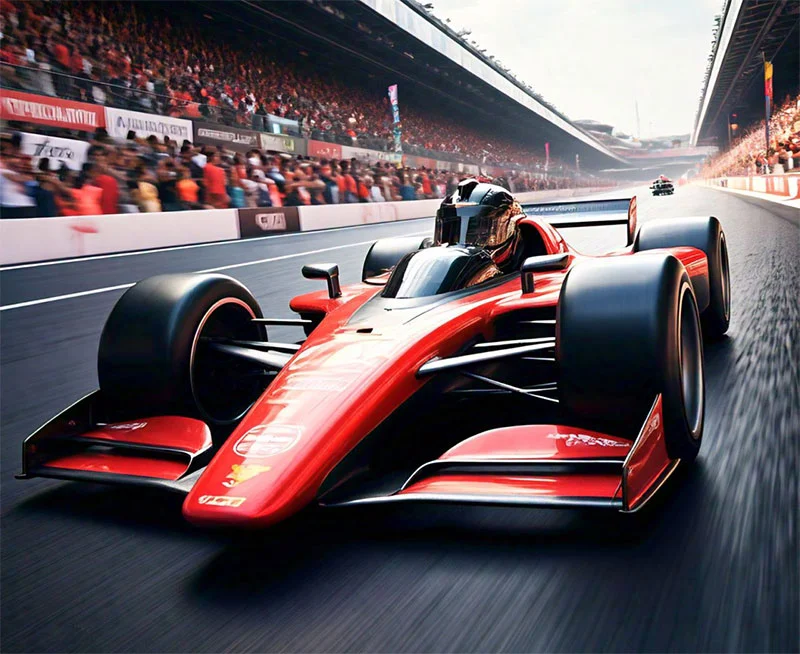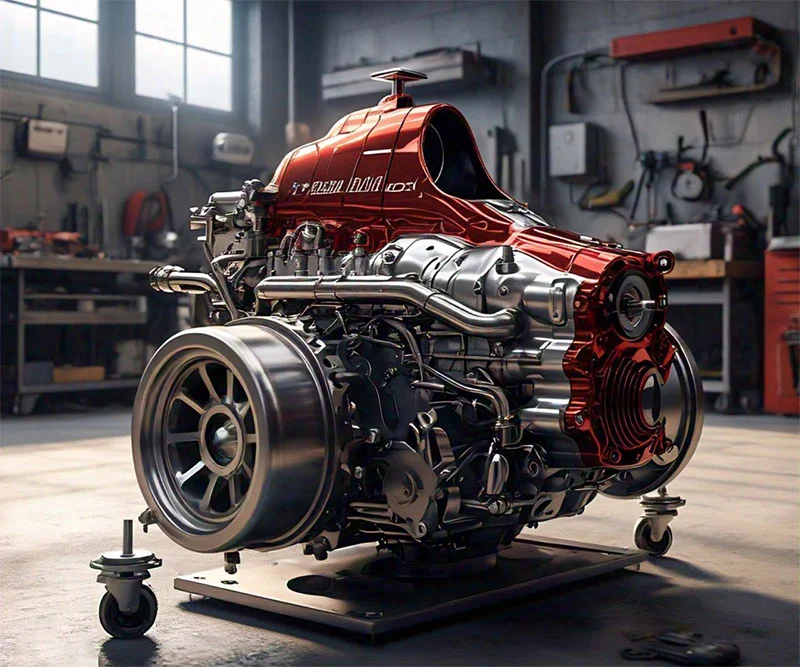How Fast Do F1 Cars Go? Ultimate Guide to Formula 1 Speeds
Formula 1 cars commonly referred to as F1 cars are engineered marvels famous for their speed, maneuverability and accuracy. Every aspect of their design the aerodynamics of the car, and the hybrid engines make them the fastest cars motorsport.
This ultimate guide explores how fast do f1 cars go, focusing on the factors influencing speed, track conditions, historical records, and future advancements.
How Fast Do F1 Cars Go: Key Factors Influencing Speed
F1 cars attain such high speeds by a closely meshed mix of part design, part engineering and a certain amount of technology. Here’s a breakdown of the key factors influencing their performance:

1. Aerodynamics
It might be said that aerodynamics is one of the main reasons that affect F1 car speeds. The body of the car has been made aerodynamically efficient to achieve as low drag as possible but a huge amount of down force for greater grip in high speed turns. Key aerodynamic features include:
- Front and Rear Wings: They make direct airflow to ensure stability.
- Diffusers: Sitting beneath the car, their purpose is to regulate the air to enhance the ground effect.
- Ground Effect Floors: Some of which have been reintroduced in the recent seasons and they create sort of a suction, and they enhance grip though they give some drag.
2. Lightweight Materials
In the F1 cars Chassis and body work are made up of carbon fiber material. It also has a lightweight strength that makes the vehicles lightweight enabling them to accelerate more and maneuver easier.
3. Engine Power
Combined in F1 cars, the power units have a 1.6-litre V6 turbocharged engine and have linked electric motors and deliver over 1000 bhp. These are great pieces of engineering; the current generation can rocket a car to 60 miles per hour within two seconds.
4. Tires
Pirelli also produces racing tires designed for use by F1 car racer. The tires are made with soft compound offering good traction but depreciates fast; this makes tire management a key factor to race strategy.
5. Track Conditions
Superiorities and deficits or the track surface, temperature, and weather conditions have a potential of deciding an F1 car performance. Edge contact, traction and temperature are factors where smooth to tactile textures and hot climate are most desirable.
Maximum Speed F1 Cars Can Reach: Breaking the Limits
In normal race circuits F1 cars are capable of achieving optimum speeds which are approximately 220 mph (354 km/h). However, this is not their absolute limit:
- The record speed of the F1 car is 246.9 mph has been set by Honda’s RA106 during the test drive at Bonneville Salt Flats in 2006.
Race conditions will hardly ever let cars reach their top speed because of course features including racetrack terrain, safety concerns, and fuel conservation.

F1 Cars Speed in Different Circumstances
An F1 car is, in many ways at the mercy of its external environment; aggressive weather patterns, altitude, and the irregularity of the race course all have impacts on how fast do f1 cars go.
1. Weather
This is because rain makes the having of the car very difficult thus denying drivers the ability to maintain high speeds. On the other hand, dry and sunny environmental conditions promote the efficiency of the tires to provide variation to the lap times.
2. Altitude
High altitude circuits like the Mexico City’s Autódromo Hermanos Rodríguez bring different questions. The thinner air has the effect or reducing down force and engine power, therefore, the top speeds are slightly lower.
3. Fuel Load
In the beginning of a race, cars take a maximum amount of fuel they can and therefore will be lighter and faster. Fuel is consumed during a race, and therefore the cars become light which in a bid to increase their speed make more laps in the next round.
The Average Speed of F1 Cars and How it Varies Between Tracks
F1 races take place on different types of track; some are fast like Monza, while others are slow, complex like Monaco track. This diversified characteristic is very useful in the determination of the speeds of the cars within a given track.

Comparing Speeds Typical to Famous GP Circuits
- Monza (Italy): Long straights and a small number of corners mean Monza, also referred to as the Temple of Speed, enables cars to achieve 220 mph.
- Monaco: This is a rather slow street circuit with the cars running at approximately 170 mph because of sharp turns and short stretches.
- Spa-Francorchamps (Belgium): This track has both straightaway and complex turns – it enables as much as a speed of 210 miles per hour.
The application of Track Design and Its Effect on Speed
One of the areas that will dictate how it is possible for the Formula 1 cars to go is through track design. Straight tracks such as Monza hence these circuits provide an avenue for reaching top speeds of over 220 Mph because there are hardly any turns.
Hence actions like Monaco, which has tight corners, narrow tracks, and involves more agility and frequent use of brakes, are slow with an average speed of 170 mph, and it also depends on features like elevation changes, sharpness of the corner and the type of surface.
Chiefs of engineers change car specifications so that drivers can achieve high speed with regard to each track’s characteristics to tackle in races.
Aerodynamics And How Changes Made In Design Can Lead To Changes In Speed
Aerodynamics are perhaps one of the most crucial aspects of the construction of the Formula 1 car. This design means there will be small air resistance (drag) yet lots of downforce which pushes the car firmly onto the track for better adhesion when cornering at high speeds.
Some of the primary aerodynamic parts include; the front wing and rear wing, ground effect floors, and diffusers. These components manage airflow effectively and provide sturdiness and steering at velocities more than 200 mph of speed. Drivers are able to reverse Drag Reduction System (DRS) to minimize straight-line drag for enhanced overtaking.

Innovations in aerodynamic rules including, those implemented in 2022, policy the ground-effect designs to advance performance without producing ‘dirty air.’ This innovation decreases the disturbance for the following vehicles and promotes better proximity racing and overtaking prospects.
Constantly there is an optimization of designs where the straight-line speed will be matched with grip in the corners depending on the needs of the circuit. Experiments have shown that changes in the aerodynamics of a car dramatically affect its behavior.
For instance, a high-downforce configuration enhances stability to turn compared to other cars, but this implies a low-speed on straights, and the low part of the downforce car is best suited for high-speed circuits such as Monza. Such decisions include; the type of track layout that is the racing surface, weather conditions that are favorable or otherwise for racing and the overall strategies in races.
Engine Power and F1 Car Speed

F1 Engines Technology
Formula 1 engines can be considered as some of the most beautiful and high performance pieces of engineering achievements using modern day technology to produce quite powerful and efficient engines. F1 current generation cars employ hybrid power units comprising of a 1.6-liter V6 turbocharged ICE and ERS. The ERS has two components:
- MGU-K (Motor Generator Unit – Kinetic): Made to retrieve energy that is produced when a car is halting and transform this to an electrical energy.
- MGU-H (Motor Generator Unit – Heat): Absorbs energy from the heat of the turbocharger.
Combined, such systems produce more than 1,000 horsepower, so the commercial F1 cars can go from standstill to 60 mph in two seconds and on average and go above 220 mph. Though these engines are very strong and performative, they have been developed with an eye towards their fuel efficiency drawing only 110 kilograms of fuel in a race.
Evolution of F1 Engines
F1 engines have been developed over the years since the sport began half a century ago in 1950. Initial engines were normally aspirated with significantly greater engines producing in the region of 300 horsepower. By 1980s, turbo charged engines were the order of the day, with many cars developing over 1,400 horsepower on qualifying runs.
Yet, issues related to safety and reliability issued changes. From the beginning of the 2000s, fast cars came with V10 and later V8 engines that provided high levels of supported power. Season 2014 brought in the hybrid V6 engines, bringing change to sustainability and efficiency with the speed as well.
This change is seen best to signify F1’s willingness to top advanced technologies it had fostered while addressing more contemporary issues such as the effects on the environment and sustainability.
Speed Records And The Fastest Formula One Cars Ever
In the case of cars the RA106 made by Honda holds the record of highest top speed of 246.9 mph (397.4 km/h) in the Bonneville Salt Flats after the company modified it. However, in competitive racing, speeds range only up to maximum speed of 220 mph.
Historical vs. Modern Speeds
- Past Generations: The initial cars of F1, in the 50’s, attaineda a speed of about 190mph. However, they did not have the aerodynamics and safety in them as is available now.
- Modern Cars: Modern day F1 cars are not only faster but also offers the ability of sharper cornering than any of its predecessors.
Why Is F1 The Fastest Cars In Motorsports
To understand the differences, let’s compare some of the various F1 Cars with typical IndyCar speeds and MotoGP occasions.
- IndyCar: That is because IndyCars can go as fast as 240 mph on ovals but F1 cars are faster on circuits thanks to better aerodynamics.
- MotoGP: MotoGP bikes have a maximum speed of 220 mph, but they don’t corner at those speeds since their downforce is less than it is in the pits.
Speed Vs. Efficiency: How Fast Can F1 Cars Go On Limited Fuel?
F1 has regulations whereby teams can use only 110 kg of fuel per race in addition to the fastest speed in racing. Regenerative braking is used through hybrid technology to ensure that energy lost during the braking system is stored in the battery and retrievable for acceleration. Such balance is achieved to provide competitive speeds while at the same time being assessable to fuel.
Conclusion: The Future of F1 Car Speed
Thus preserving speed for the future of F1 lies in such advancements. In the process of shifting to carbon neutrality within the sport by 2030, electric and hybrid systems may shift the boundaries of speed. What might be achieved in terms of aerodynamics, materials for constructors, and energy recovery systems will determine how far can be driven the development of the F1 cars.
F1 still remains the measurement stick in terms of speed and engineering with fans all over the world being indulged with nothing but an unrelenting battle. Of course as in most technological areas, the speed and capabilities of these fantastic machines will advance, guaranteeing that spectacular remains at the very cutting edge of speed and power in motor racing.
